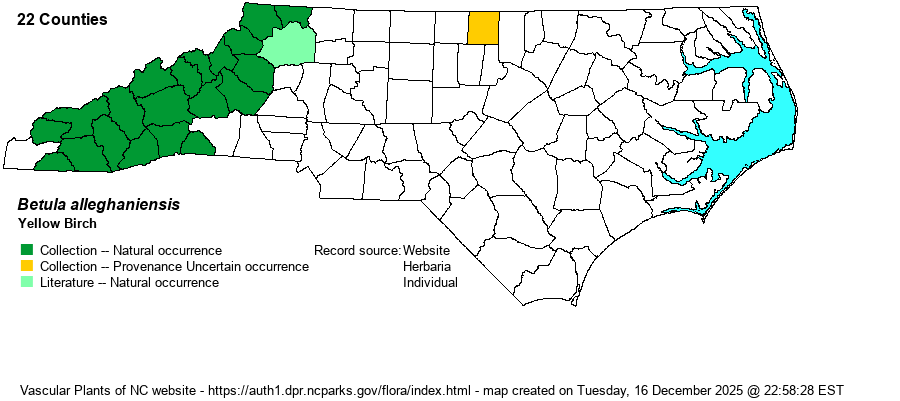| Author | Britton | |
| Distribution | Strictly in the Mountains, and limited to the higher elevations, mostly over 4000 feet. A record (specimen?) from Person County in the eastern Piedmont must relate to an escape.
As expected for a montane species, this is a Northern species ranging across the eastern half of Canada and northeastern U.S., south to PA, and in the Appalachians, barely to northern GA and eastern TN. Interestingly, in TN and KY it occurs in low mountains in the Cumberlands.
| |
| Abundance | Common at the higher elevations, and is one of the most numerous (if not the most numerous) hardwood tree species above 5000 feet. Much less numerous lower than 5000 feet. | |
| Habitat | This is a dominant canopy tree of mixed hardwood-spruce forests, and scattered in spruce-fir forests. It also occurs in hardwood forests away from spruce and fir, usually in cool microclimates such as sheltered slopes. |
| Phenology | Flowers in April, and fruits from June to August. | |
| Identification | This is a medium-sized deciduous tree with characteristic peeling or curled dull gold-colored bark (not “yellow” despite the common name). It reaches about 50-60 feet high. The leaves are elliptic to ovate with serrated margins to about 3 inches long, and like all birches have strongly parallel leaf veins. The twigs are quite aromatic when broken, though not quite as strongly scented as B. lenta. These two birches can be confused, and they often grow together at middle elevations. Generally, you must identify them by bark color and flaking, as B. lenta has dark brown bark that does not usually have such large and obviously peeling bark. In a few small areas, mainly at Mount Mitchell State Park, the similar B. cordifolia occurs, as does B. alleghaniensis. B. cordifolia has white and strongly peeling bark, and its leaves are cordate at the base as opposed to rounded at the base in B. alleghaniensis. | |
| Taxonomic Comments | This tree was long named as Betula lutea. Also, some references list varieties for this species, though most (including this website) do not.
| |
| Other Common Name(s) | None | |
| State Rank | S5 | |
| Global Rank | G5 | |
| State Status | | |
| US Status | | |
| USACE-agcp | FACU link |
| USACE-emp | FAC link |

